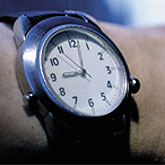How We Use Crystals To Tell Time

Quartz crystal clocks were better because they had no gears or escapements to disturb their regular frequency. Even so, they still relied on a mechanical vibration whose frequency depended critically on the crystal's size, shape and temperature. Thus, no two crystals can be exactly alike, with just the same frequency. Such quartz clocks and watches continue to dominate the market in numbers because their performance is excellent for their price. But the timekeeping performance of quartz clocks has been substantially surpassed by atomic clocks.
About the Author
NIST General
 The National Institute of Standards and Technology is a physical sciences laboratory and a non-regulatory agency of the United States Department of Commerce. Its mission is to promote innovation and industrial competitiveness.
The National Institute of Standards and Technology is a physical sciences laboratory and a non-regulatory agency of the United States Department of Commerce. Its mission is to promote innovation and industrial competitiveness.


